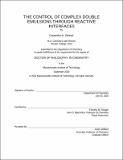The control of complex double emulsions through reactive interfaces
Author(s)
Zentner, Cassandra A.(Cassandra Aileen)
Download1227703919-MIT.pdf (15.08Mb)
Other Contributors
Massachusetts Institute of Technology. Department of Chemistry.
Advisor
Timothy M. Swager.
Terms of use
Metadata
Show full item recordAbstract
This thesis summarizes the use of interfacial reactions, responsive surfactants, and specific tuning of interfacial tensions to discover novel ways to manufacture and manipulate dynamic double emulsion systems. In Chapter 1, we introduce emulsions and surfactants. We describe the fabrication of emulsions and creating stimuli responsive systems. Finally, we explore the relatively recent research into dynamic double emulsions, which is explored further in this thesis. In Chapter 2, we demonstrate the use of selective, interfacial imine formation at emulsion interfaces for the in situ formation of surfactants for novel manufacturing of emulsions and biosensors, dynamic morphology changes through perturbing imine equilibria, and the destruction of emulsions with imine formation at the emulsion-solid interface. In Chapter 3, we introduce surfactants that localize at the internal interface of double emulsions, which enables the incorporation of liquid crystals into dynamically reconfigurable complex emulsions. Further, we demonstrate that isomerization of a photo-responsive azobenzene surfactant at the internal interface of liquid crystal double emulsions results in reversible morphology change. In addition, isomerization of the azobenzene internal surfactant results in overall droplet movement, both orientational and translational. In Chapter 4, we describe that interfacial confinement of magnetic nanoparticles to emulsions interfaces, accomplished through interfacial imine formation, imparts ferromagnetic behavior to dynamic double emulsion comprising isotropic solvents. Further, we demonstrate liquid crystal double emulsions enable precise assembly of magnetic nanoparticles at the emulsion interface and can produce droplets movement and reorganization of the director field. In Chapter 5, we synthesize nucleophile-responsive surfactants with Michael acceptor functionalities to create responsive single and double emulsions. We demonstrate the emulsion systems are responsive to both small nucleophiles and polymeric nanoassemblies. Further, we describe the use of an unrelated stimuli, light, to trigger a cascade that results in emulsion responses.
Description
Thesis: Ph. D., Massachusetts Institute of Technology, Department of Chemistry, September, 2020 Cataloged from student-submitted PDF of thesis. Includes bibliographical references (pages 196-207).
Date issued
2020Department
Massachusetts Institute of Technology. Department of ChemistryPublisher
Massachusetts Institute of Technology
Keywords
Chemistry.